Application of Meta-Heuristic Techniques for Optimal Load Shedding in Islanded Distribution Network with High Penetration of Solar PV Generation
Abstract
:1. Introduction
2. Methodology of Proposed UFLS Technique
2.1. Frequency Calculator Unit (FCU)
2.2. Imbalance Power Calculator Unit (IPCU)
2.2.1. Event Based
2.2.2. Response Based
2.3. Load Shedding Unit (LSU)
3. Problem Formulation
3.1. Application of Meta-Heuristics Techniques for UFLS Technique
3.1.1. Implementation of Binary Evolutionary Programming (BEP)
Initialization and Fitness
Mutation
Combined and Selection
3.1.2. Implementation of Binary Genetic Algorithm (BGA)
3.1.3. Implementation of Binary Particle Swarm Optimization (BPSO)
3.2. Using UFLS Technique Based on Fixed and Random Proiority of Loads (UFLS-FRPL)
4. Distribution Network Modeling
4.1. Modeling of Distribution Network Loads
4.2. Model of Solar Photovoltaic Generation
4.2.1. Solar PV Array
4.2.2. DC-DC Converter
4.2.3. MPPT Controller of Solar PV
4.2.4. Three Phase Inverter
5. Simulation Results
- The first case study represents the effect of increasing of PV penetration in distribution network.
- The second case represents the comparative study between UFLS scheme and adaptive UFLS controller to show the importance of assuming some flexibility in load shedding priority.
- The third case represents a comparative simulation study between, BGA, BPSO, method proposed in [30], and BEP in terms of execution time and convergence curves.
- The fourth case study represents the simulation study of UFLS scheme using BEP, BGA, and BPSO techniques, and method proposed in [30].
5.1. First Case Study
5.2. Second Case Study
Comparing the Operation of Proposed UFLS Scheme with Adaptive UFLS
5.3. Third Case Study
5.4. Fourth Case Study
5.4.1. Simulation Study of UFLS Scheme Using BEP, BGA, BPSO Techniques, and UFLS-FRPL
Load Increment of 1 MW occurred at 40 s after Islanding
Intentional Islanding at 1.56 MW Imbalance Power
Mini-Hydro DG Tripping at 40 s after Islanding
6. Discussion
7. Conclusions and Future Research
Acknowledgments
Author Contributions
Conflicts of Interest
References
- Ruska, M.; Kiviluoma, J. Renewable Electricity in Europe. Current State, Drivers, and Scenarios for 2020; VTT Technical Research Centre of Finland: Otaniemi, Finland, 2011; p. 72. [Google Scholar]
- Basso, T. IEEE Standard for Interrconnecting Distributed Resources with the Electric Power System; Institute of Electrical and Electronics Engineers: Piscataway, NJ, USA, 2004; p. 1. [Google Scholar]
- Khamis, A.; Shareef, H.; Mohamed, A.; Bizkevelci, E. Islanding detection in a distributed generation integrated power system using phase space technique and probabilistic neural network. Neurocomputing 2015, 148, 587–599. [Google Scholar] [CrossRef]
- Hashemi, F.; Ghadimi, N.; Sobhani, B. Islanding detection for inverter-based DG coupled with using an adaptive neuro-fuzzy inference system. Int. J. Electr. Power Energy Syst. 2013, 45, 443–455. [Google Scholar] [CrossRef]
- Lee, S.-H.; Park, J.-W. New islanding detection method for inverter-based distributed generation considering its switching frequency. IEEE Trans. Ind. Appl. 2010, 46, 2089–2098. [Google Scholar] [CrossRef]
- Xu, D.; Girgis, A.A. Optimal load shedding strategy in power systems with distributed generation. In Proceedings of the 2001 IEEE Power Engineering Society Winter Meeting, Columbus, OH, USA, 28 January–1 February 2001; pp. 788–793.
- Laghari, J.; Mokhlis, H.; Bakar, A.; Mohamad, H. Application of computational intelligence techniques for load shedding in power systems: A review. Energ. Convers. Manag. 2013, 75, 130–140. [Google Scholar] [CrossRef]
- Tang, J.; Liu, J.; Ponci, F.; Monti, A. Adaptive load shedding based on combined frequency and voltage stability assessment using synchrophasor measurements. IEEE Trans. Power Syst. 2013, 28, 2035–2047. [Google Scholar] [CrossRef]
- Anderson, P.; Mirheydar, M. An adaptive method for setting underfrequency load shedding relays. IEEE Trans. Power Syst. 1992, 7, 647–655. [Google Scholar] [CrossRef]
- Jung, J.; Liu, C.-C.; Tanimoto, S.L.; Vittal, V. Adaptation in load shedding under vulnerable operating conditions. IEEE Trans. Power Syst. 2002, 17, 1199–1205. [Google Scholar] [CrossRef]
- Tso, S.; Zhu, T.; Zeng, Q.; Lo, K. Evaluation of load shedding to prevent dynamic voltage instability based on extended fuzzy reasoning. IEE Proc. Gener. Transm. Distrib. 1997, 144, 81–86. [Google Scholar] [CrossRef]
- Sasikala, J.; Ramaswamy, M. Fuzzy based load shedding strategies for avoiding voltage collapse. Appl. Soft Comput. 2011, 11, 3179–3185. [Google Scholar] [CrossRef]
- Mokhlis, H.; Laghari, J.; Bakar, A.; Karimi, M. A fuzzy based under-frequency load shedding scheme for islanded distribution network connected with DG. Int. Rev. Electr. Eng. 2012, 7, 4992–5000. [Google Scholar]
- Mahat, P.; Chen, Z.; Bak-Jensen, B. Underfrequency load shedding for an islanded distribution system with distributed generators. IEEE Trans. Power Deliv. 2010, 25, 911–918. [Google Scholar] [CrossRef]
- Zin, A.M.; Hafiz, H.M.; Wong, W. Static and dynamic under-frequency load shedding: A comparison. In Proceedings of the 2004 International Conference on Power System Technology (PowerCon 2004), Singapore, 21–24 November 2004; pp. 941–945.
- Hong, Y.-Y.; Wei, S.-F. Multiobjective underfrequency load shedding in an autonomous system using hierarchical genetic algorithms. IEEE Trans. Power Deliv. 2010, 25, 1355–1362. [Google Scholar] [CrossRef]
- Rad, B.F.; Abedi, M. An optimal load-shedding scheme during contingency situations using meta-heuristics algorithms with application of AHP method. In Proceedings of the 11th International Conference on Optimization of Electrical and Electronic Equipment (OPTIM 2008), Brasßov, Romania, 22–24 May 2008; pp. 167–173.
- Al-Hasawi, W.M.; El Naggar, K.M. Optimum steady-state load-shedding scheme using genetic based algorithm. In Proceedings of the IEEE 11th Mediterranean Electrotechnical Conference (MELECON 2002), Cairo, Egypt, 7–9 May 2002; pp. 605–609.
- Chen, C.-R.; Tsai, W.-T.; Chen, H.-Y.; Lee, C.-Y.; Chen, C.-J.; Lan, H.-W. Optimal load shedding planning with genetic algorithm. In Proceedings of the 2011 IEEE Industry Applications Society Annual Meeting (IAS), Orlando, FL, USA, 9–13 October 2011; pp. 1–6.
- Hong, Y.-Y.; Chen, P.-H. Genetic-based underfrequency load shedding in a stand-alone power system considering fuzzy loads. IEEE Trans. Power Deliv. 2012, 27, 87–95. [Google Scholar] [CrossRef]
- Luan, W.; Irving, M.R.; Daniel, J.S. Genetic algorithm for supply restoration and optimal load shedding in power system distribution networks. IEE Proc. Gener. Transm. Distrib. 2002, 149, 145–151. [Google Scholar] [CrossRef]
- Amraee, T.; Mozafari, B.; Ranjbar, A. An improved model for optimal under voltage load shedding: Particle swarm approach. In Proceedings of the 2006 IEEE Power India Conference, New Delhi, India, 10–12 April 2006; p. 6.
- Mozafari, B.; Amraee, T.; Ranjbar, A. An approach for under voltage load shedding using particle swarm optimization. In Proceedings of the 2006 IEEE International Symposium on Industrial Electronics, Montreal, QC, Canada, 9–13 July 2006; pp. 2019–2024.
- Sadati, N.; Amraee, T.; Ranjbar, A. A global particle swarm-based-simulated annealing optimization technique for under-voltage load shedding problem. Appl. Soft Comput. 2009, 9, 652–657. [Google Scholar] [CrossRef]
- El-Zonkoly, A.; Saad, M.; Khalil, R. New algorithm based on CLPSO for controlled islanding of distribution systems. Int. J. Electr. Power Energy Syst. 2013, 45, 391–403. [Google Scholar] [CrossRef]
- Hsu, C.-T.; Chuang, H.-J.; Chen, C.-S. Adaptive load shedding for an industrial petroleum cogeneration system. Expert Syst. Appl. 2011, 38, 13967–13974. [Google Scholar] [CrossRef]
- Hooshmand, R.; Moazzami, M. Optimal design of adaptive under frequency load shedding using artificial neural networks in isolated power system. Int. J. Electr. Power Energy Syst. 2012, 42, 220–228. [Google Scholar] [CrossRef]
- Hsu, C.-T.; Kang, M.-S.; Chen, C.-S. Design of adaptive load shedding by artificial neural networks. IEEE Proc. 2005, 152, 415–421. [Google Scholar] [CrossRef]
- Javadian, S.; Haghifam, M.-R.; Bathaee, S.; Firoozabad, M.F. Adaptive centralized protection scheme for distribution systems with DG using risk analysis for protective devices placement. Int. J. Electr. Power Energy Syst. 2013, 44, 337–345. [Google Scholar] [CrossRef]
- Laghari, J.; Mokhlis, H.; Karimi, M.; Bakar, A.H.A.; Mohamad, H. A new under-frequency load shedding technique based on combination of fixed and random priority of loads for smart grid applications. IEEE Trans. Power Syst. 2015, 30, 2507–2515. [Google Scholar] [CrossRef]
- Xia, J.; Dyśko, A.; O’Reilly, J. Future stability challenges for the UK network with high wind penetration levels. IET Gener. Transm. Dis. 2015, 9, 1160–1167. [Google Scholar] [CrossRef]
- Morren, J.; Pierik, J.; de Haan, S.W. Inertial response of variable speed wind turbines. Electr. Power Syst. Res. 2006, 76, 980–987. [Google Scholar] [CrossRef]
- Terzija, V.V. Adaptive underfrequency load shedding based on the magnitude of the disturbance estimation. IEEE Trans. Power Syst. 2006, 21, 1260–1266. [Google Scholar] [CrossRef]
- Kundur, P.; Balu, N.J.; Lauby, M.G. Power System Stability and Control; McGraw-Hill: New York, NY, USA, 1994; Volume 7. [Google Scholar]
- Wang, Q.; Tang, Y.; Li, F.; Li, M.; Li, Y.; Ni, M. Coordinated scheme of under-frequency load shedding with intelligent appliances in a cyber physical power system. Energies 2016, 9, 630. [Google Scholar] [CrossRef]
- Khamis, A.; Shareef, H.; Mohamed, A. Islanding detection and load shedding scheme for radial distribution systems integrated with dispersed generations. IET Gener. Transm. Dis. 2015, 9, 2261–2275. [Google Scholar] [CrossRef]
- Civicioglu, P. Backtracking search optimization algorithm for numerical optimization problems. Appl. Math. Comput. 2013, 219, 8121–8144. [Google Scholar] [CrossRef]
- Yuan, X.; Nie, H.; Su, A.; Wang, L.; Yuan, Y. An improved binary particle swarm optimization for unit commitment problem. Expert Syst. Appl. 2009, 36, 8049–8055. [Google Scholar] [CrossRef]
- Liu, W.; Liu, L.; Cartes, D.A.; Venayagamoorthy, G.K. Binary particle swarm optimization based defensive islanding of large scale power systems. Int. J. Comput. Sci. Appl. 2007, 4, 69–83. [Google Scholar]
- Dahej, A.E.; Esmaeili, S.; Goroohi, A. Optimal allocation of SVC and TCSC for improving voltage stability and reducing power system losses using hybrid binary genetic algorithm and particle swarm optimization. Can. J. Electr. Electron. Eng. 2012, 3, 100–107. [Google Scholar]
- Aman, M.; Jasmon, G.; Naidu, K.; Bakar, A.; Mokhlis, H. Discrete evolutionary programming to solve network reconfiguration problem. In Proceedings of the 2013 IEEE TENCON Spring Conference, Sydney, Australia, 17–19 April 2013; pp. 505–509.
- Aponte, E.E.; Nelson, J.K. Time optimal load shedding for distributed power systems. IEEE Trans. Power Syst. 2006, 21, 269–277. [Google Scholar] [CrossRef]
- Oluwadare, S.A.; Iwasokun, G.B.; Olabode, O.; Olusi, O.; Akinwonmi, A.E. Genetic algorithm-based cost optimization model for power economic dispatch problem. Br. J. Appl. Sci. Technol. 2016, 15, 6. [Google Scholar] [CrossRef]
- Thakur, P.; Singh, A.J. Study of various crossover operators in GeneticAlgorithms. Int. J. Adv. Res. Comput. Sci. Softw. Eng. 2014, 4, 7235–7238. [Google Scholar]
- Eberhart, R.C.; Shi, Y. Comparing inertia weights and constriction factors in particle swarm optimization. In Proceedings of the 2000 Congress on Evolutionary Computation, San Diego, CA, USA, 16–19 July 2000; pp. 84–88.
- Hoke, A.; Hambrick, R.B.J.; Kroposki, B. Maximum Photovoltaic Penetration Levels on Typical Distribution Feeders; National Renewable Energy Laboratory: Golden, CO, USA, 2012.
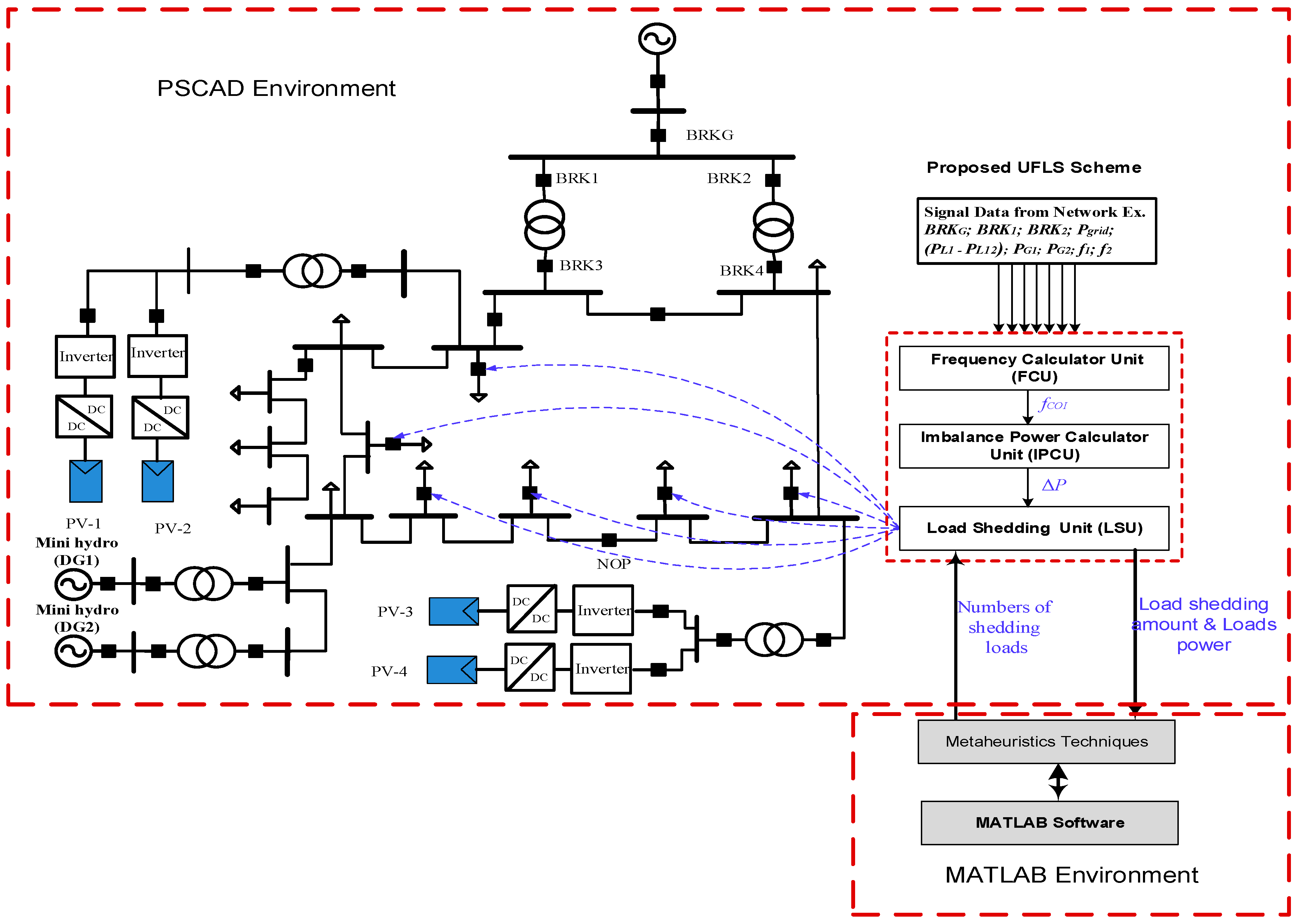
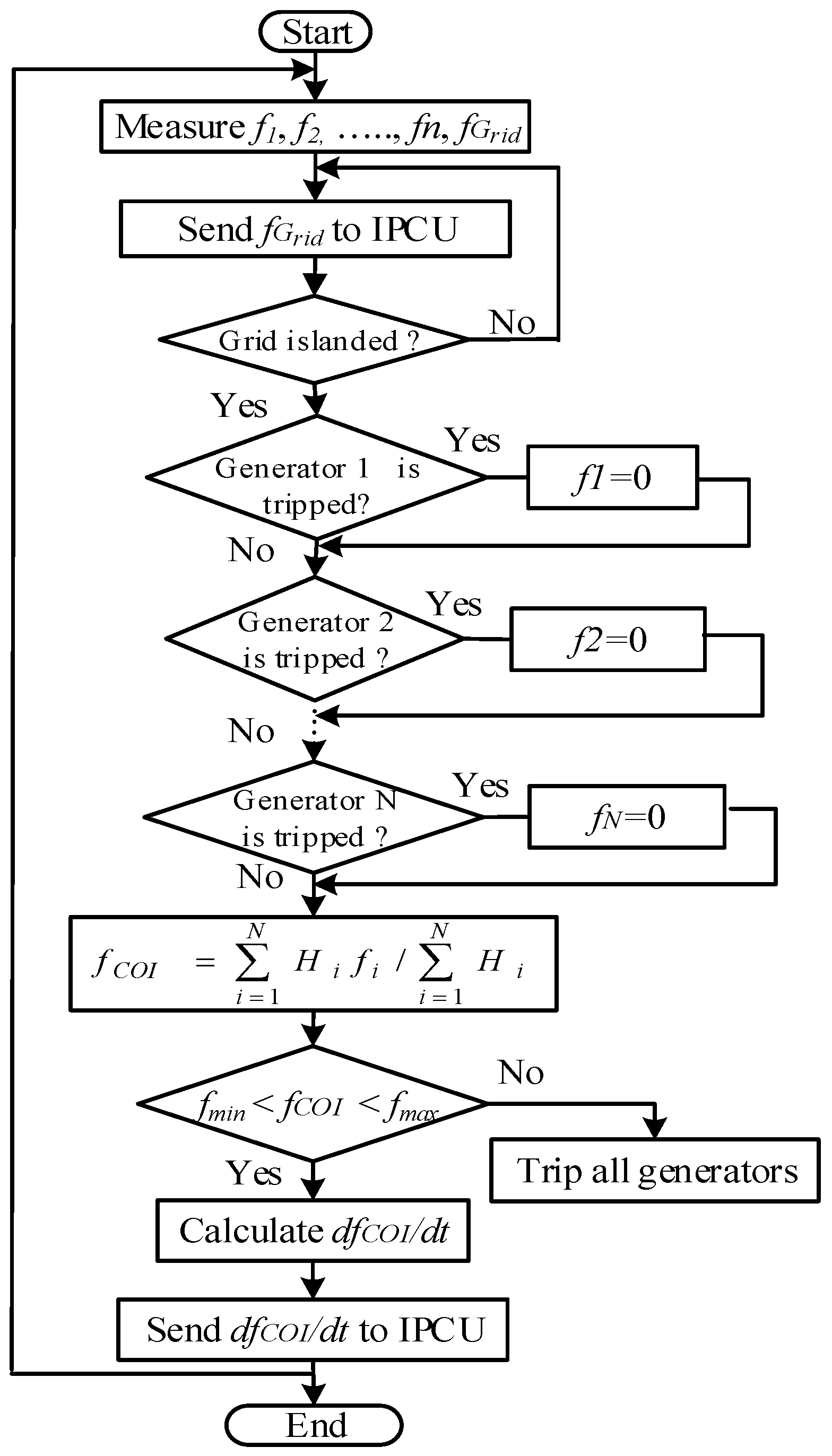
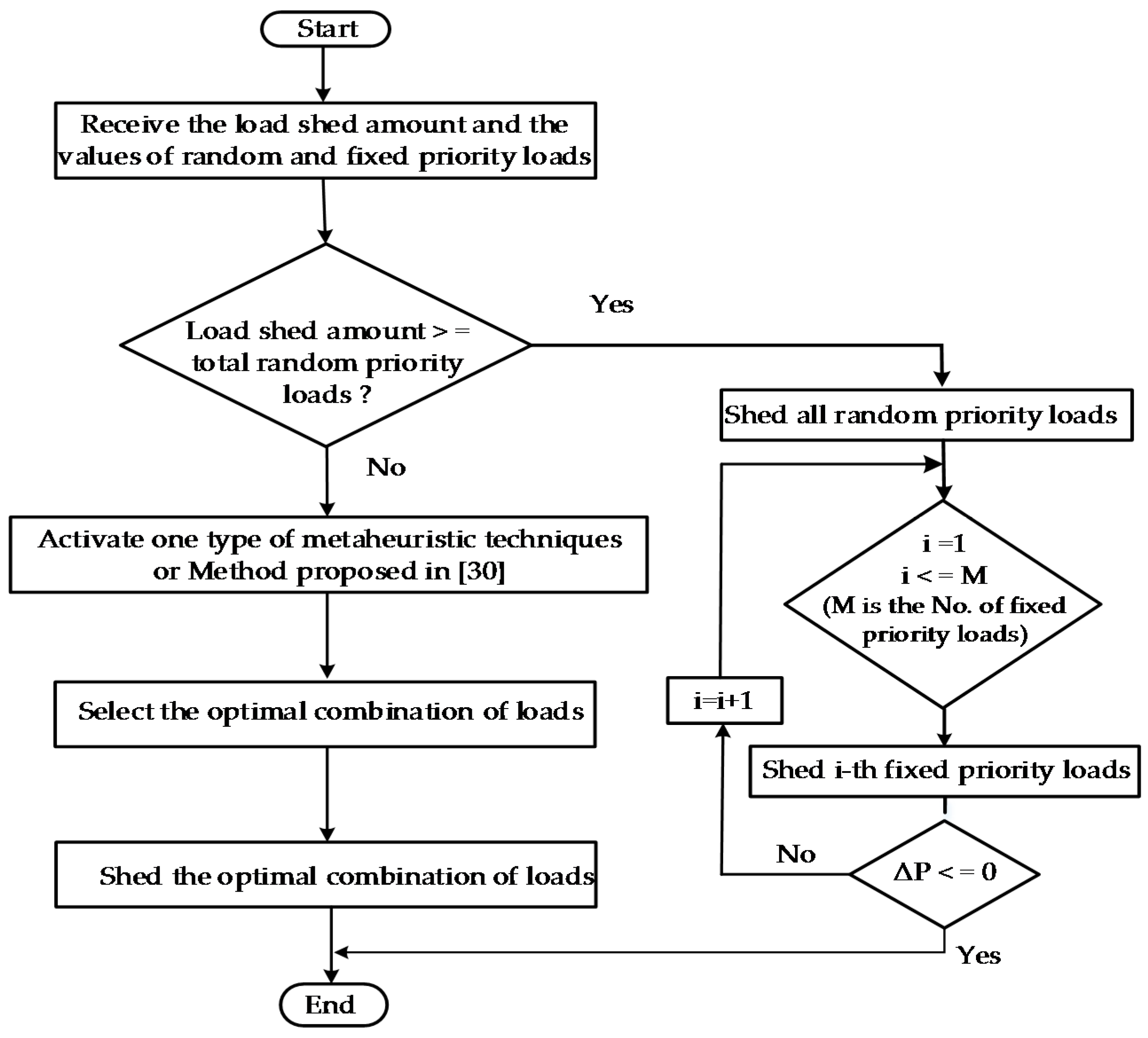
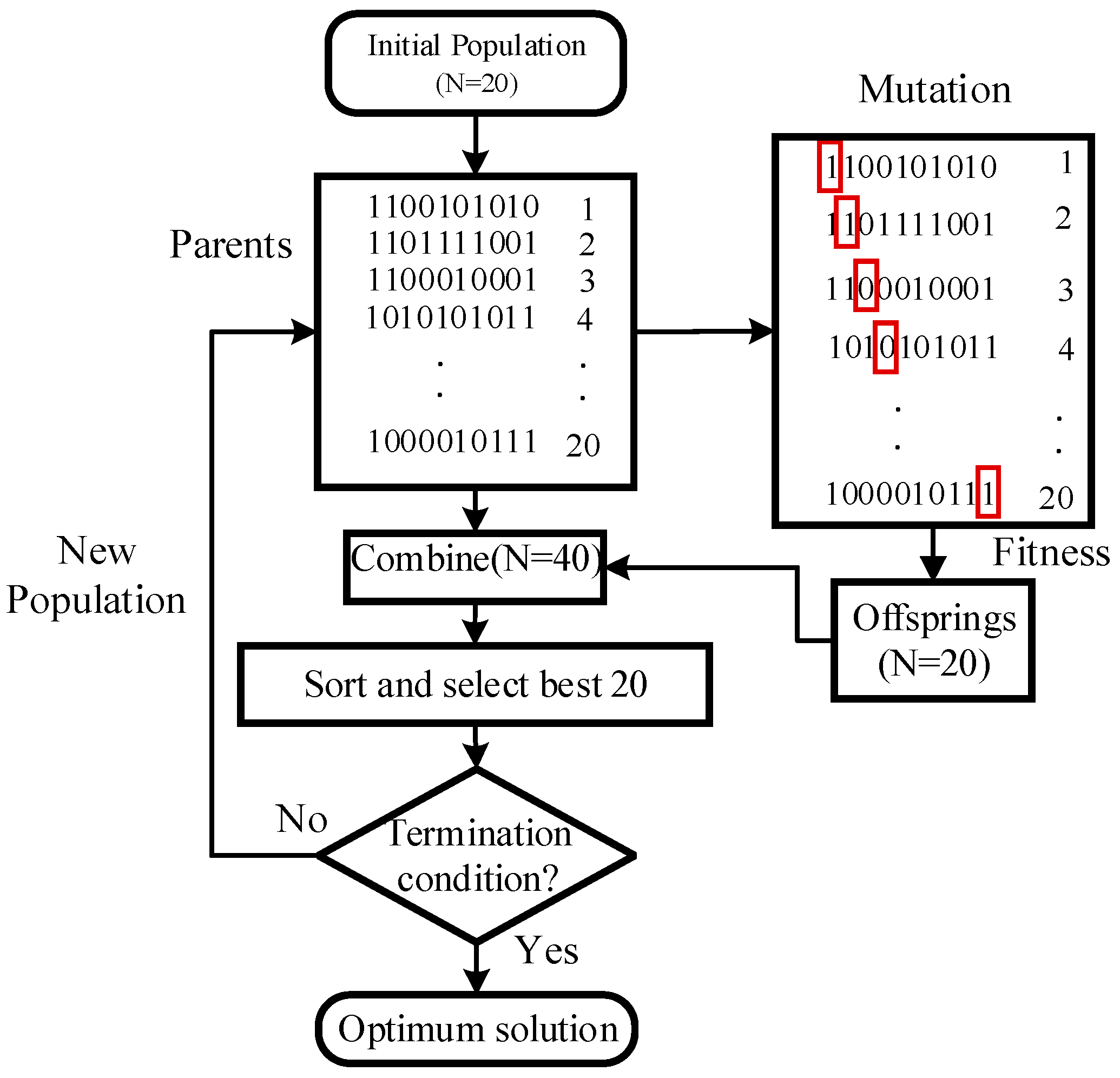
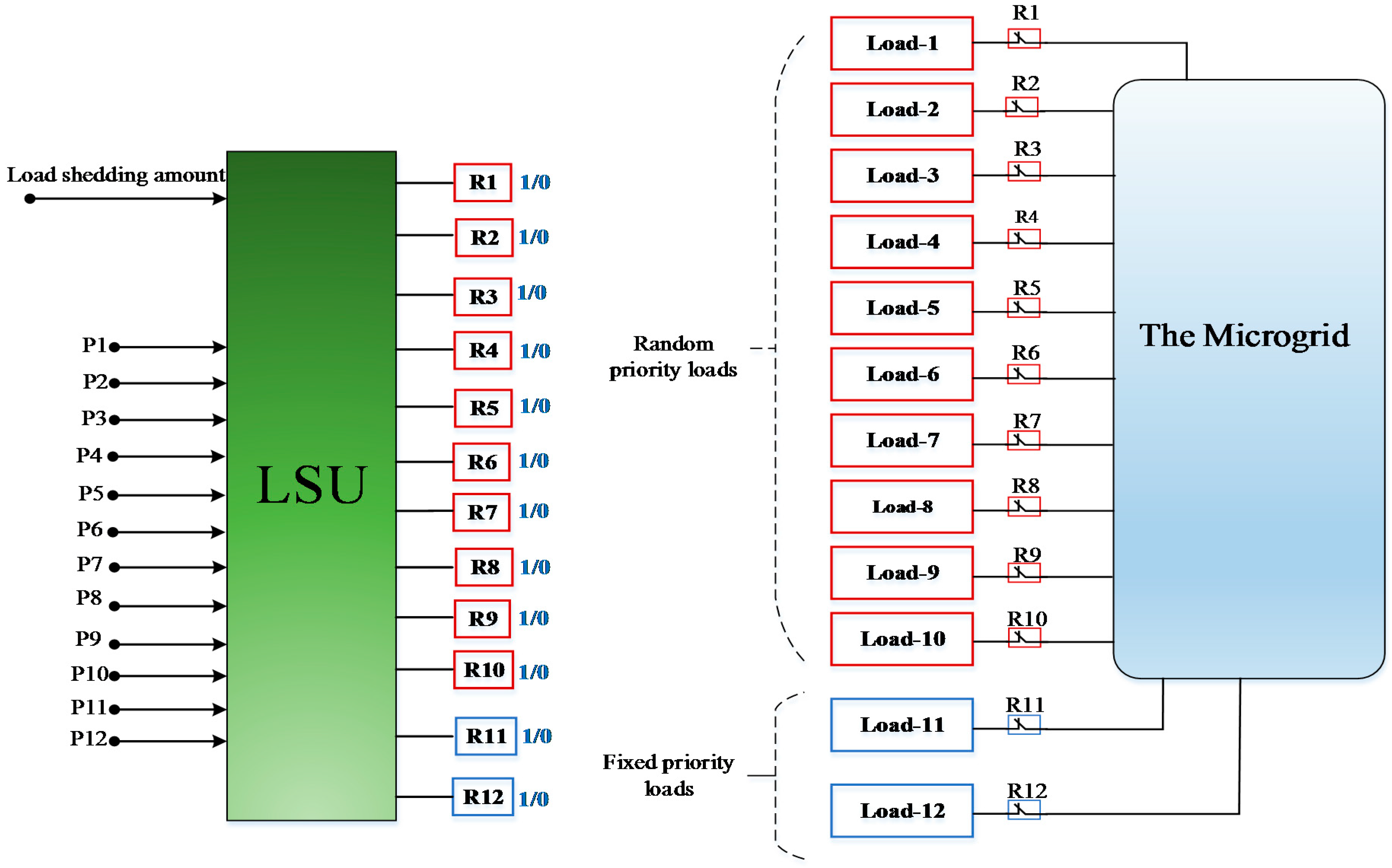
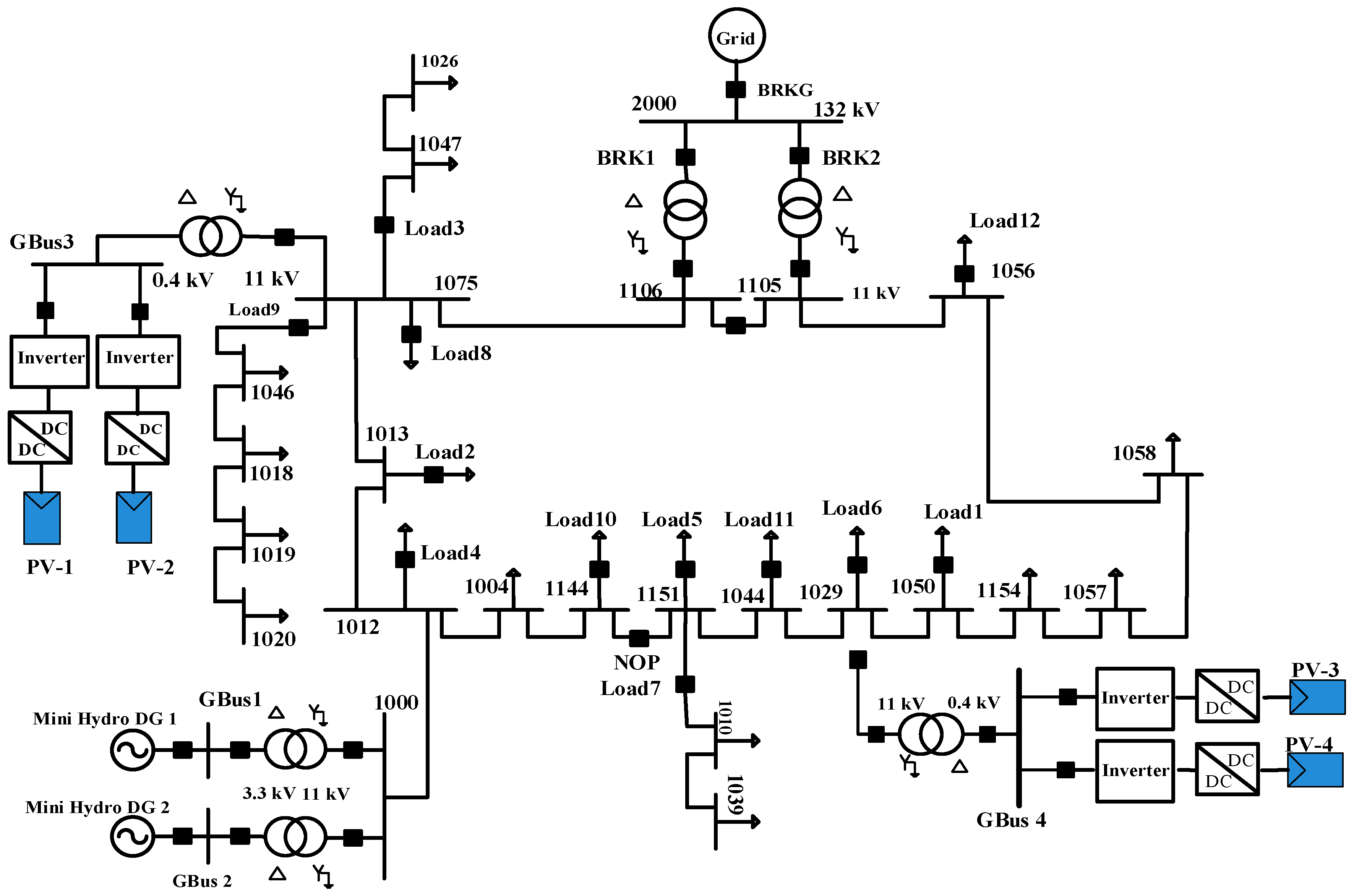

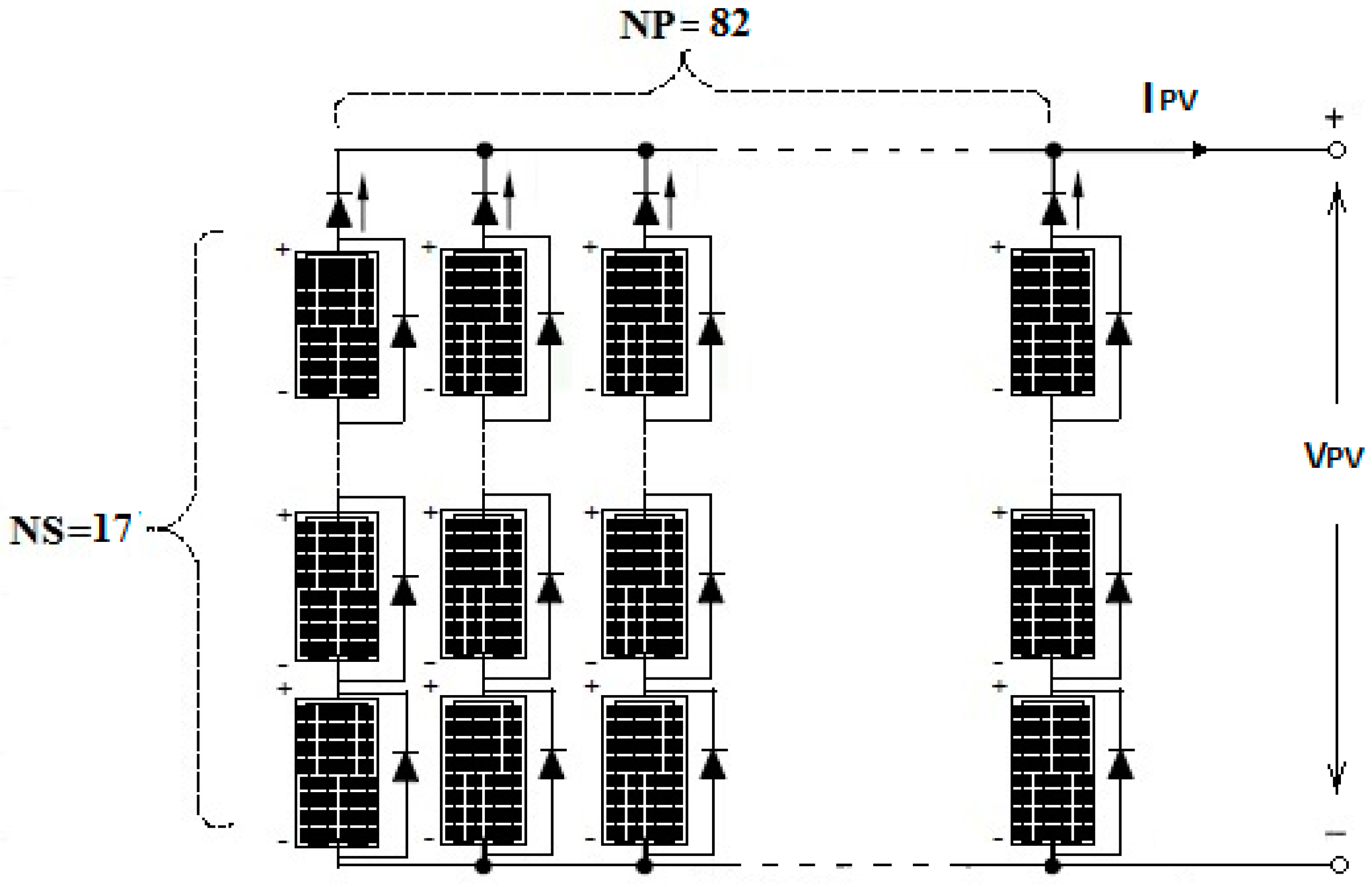


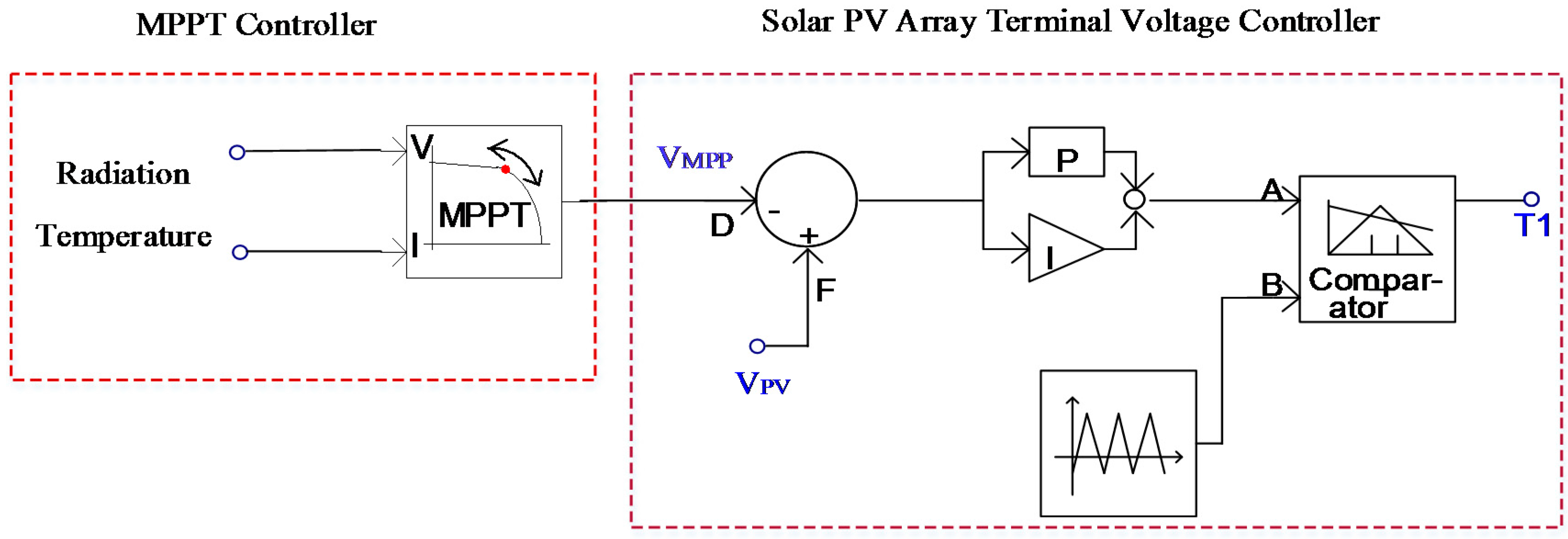
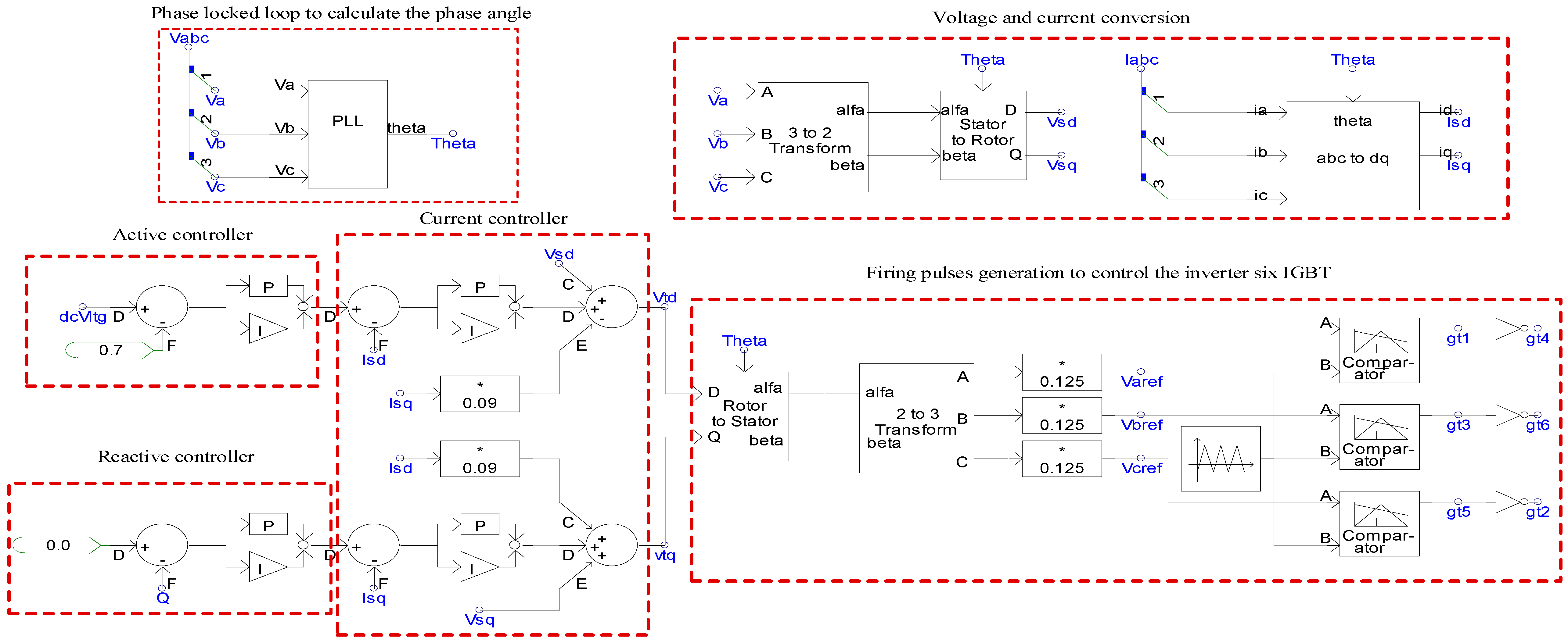
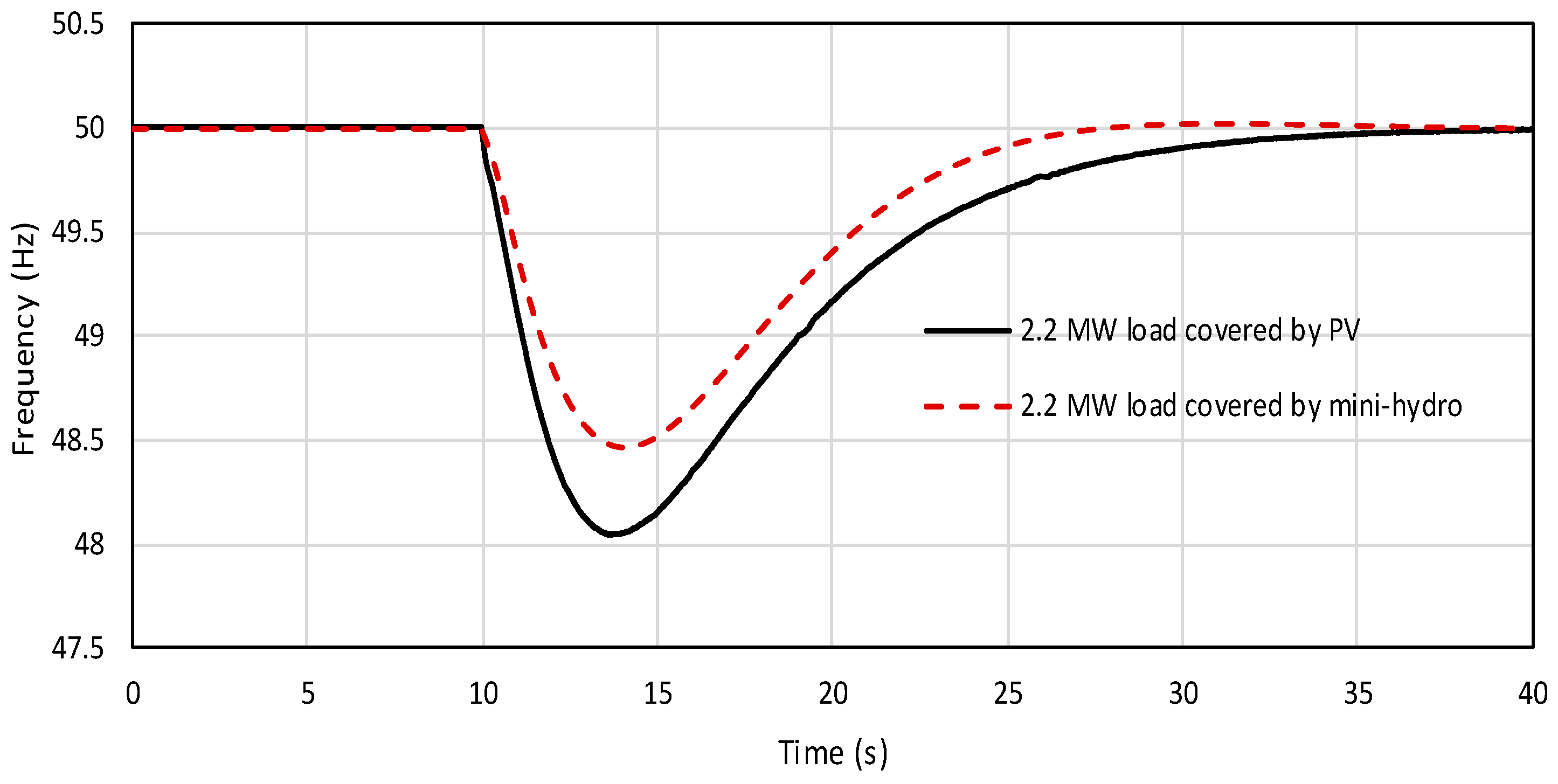
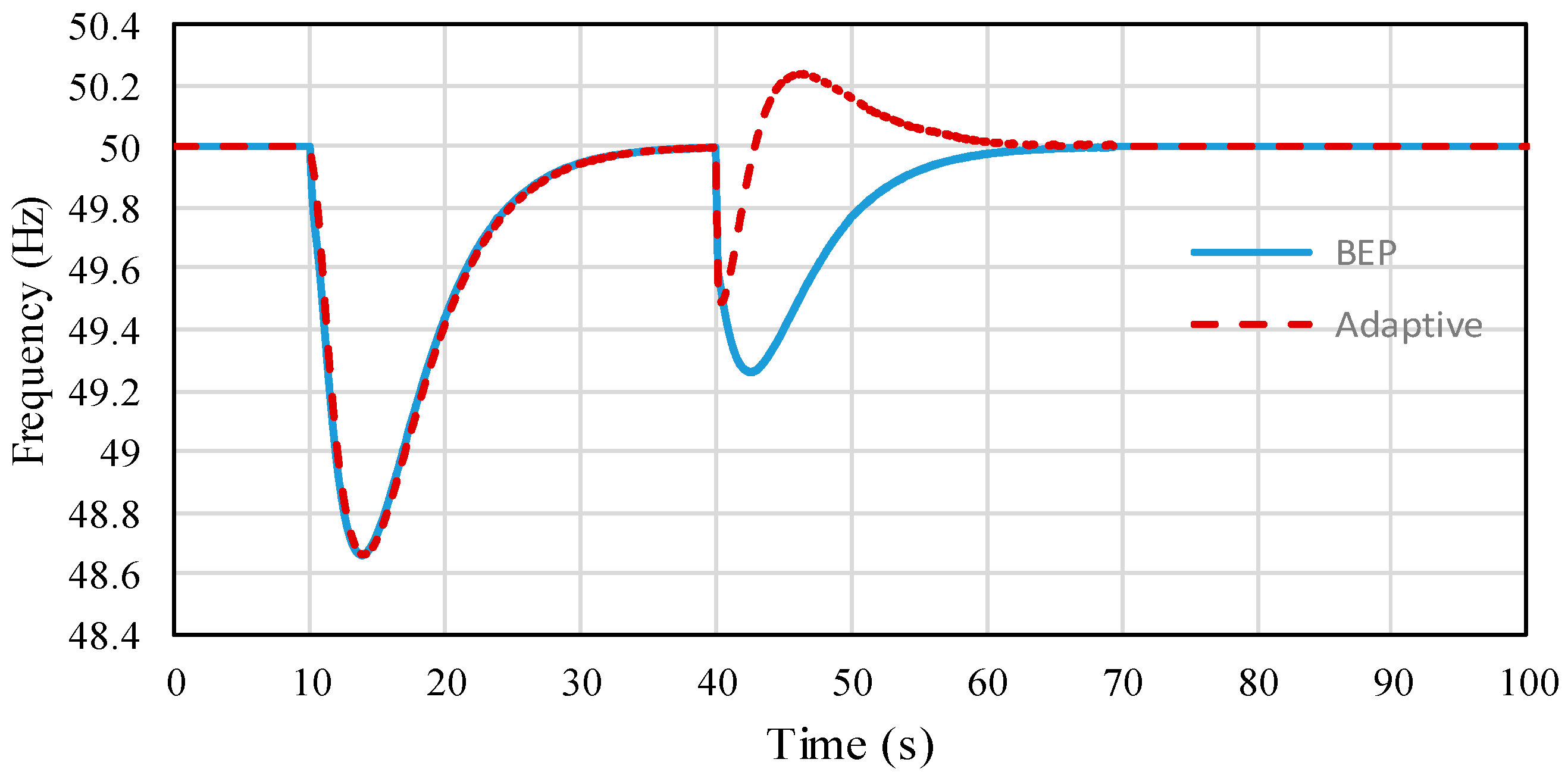
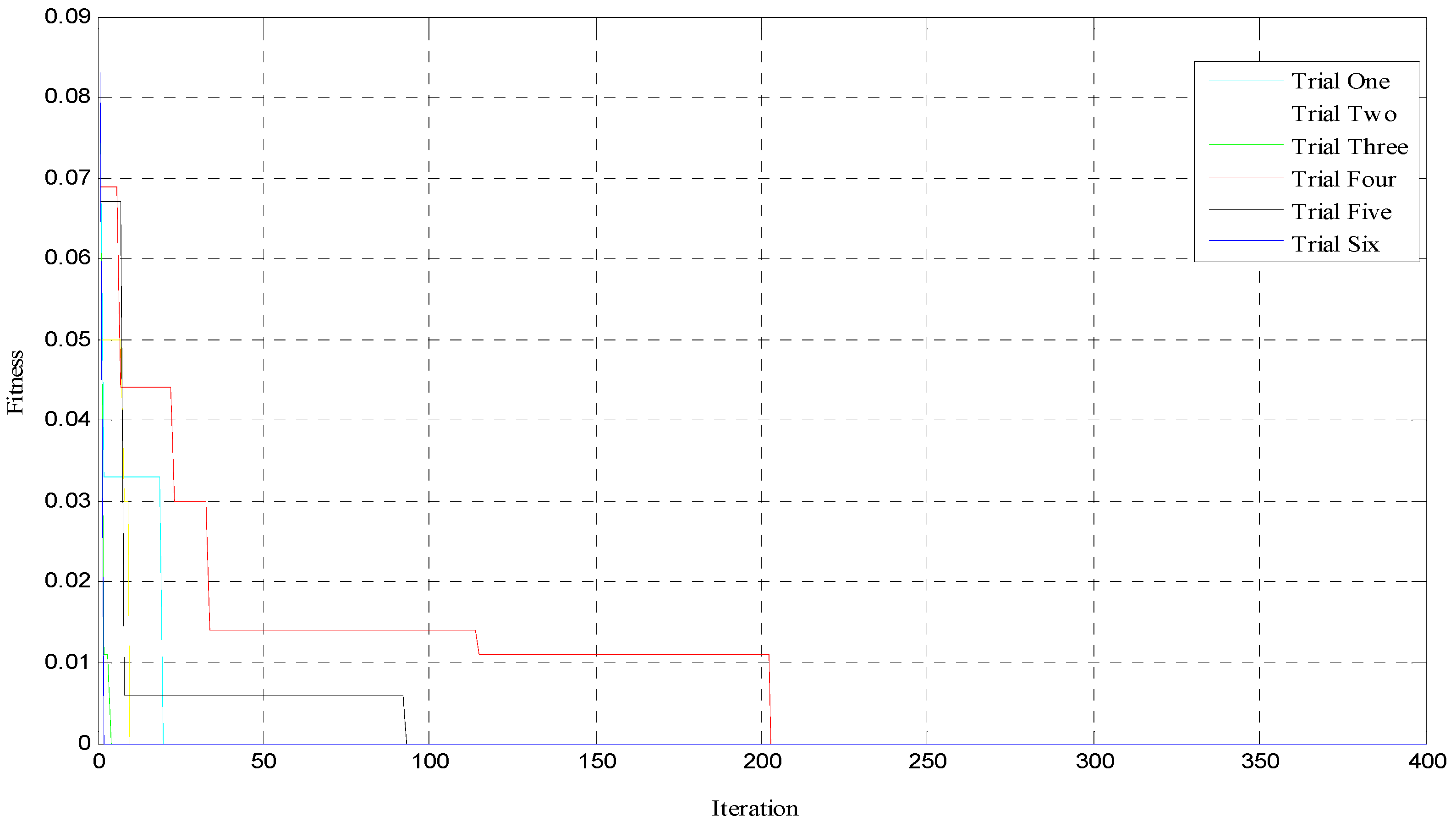

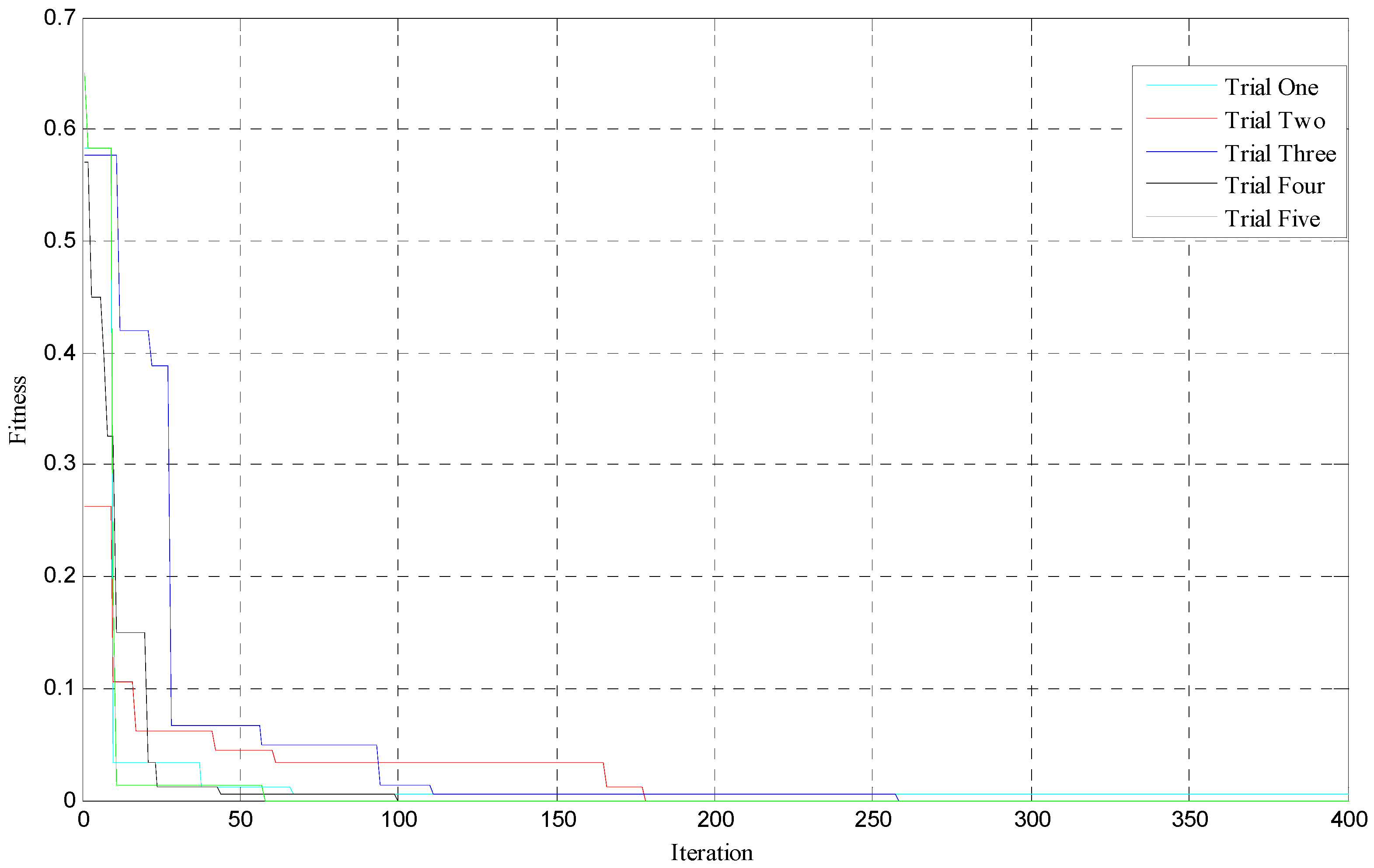
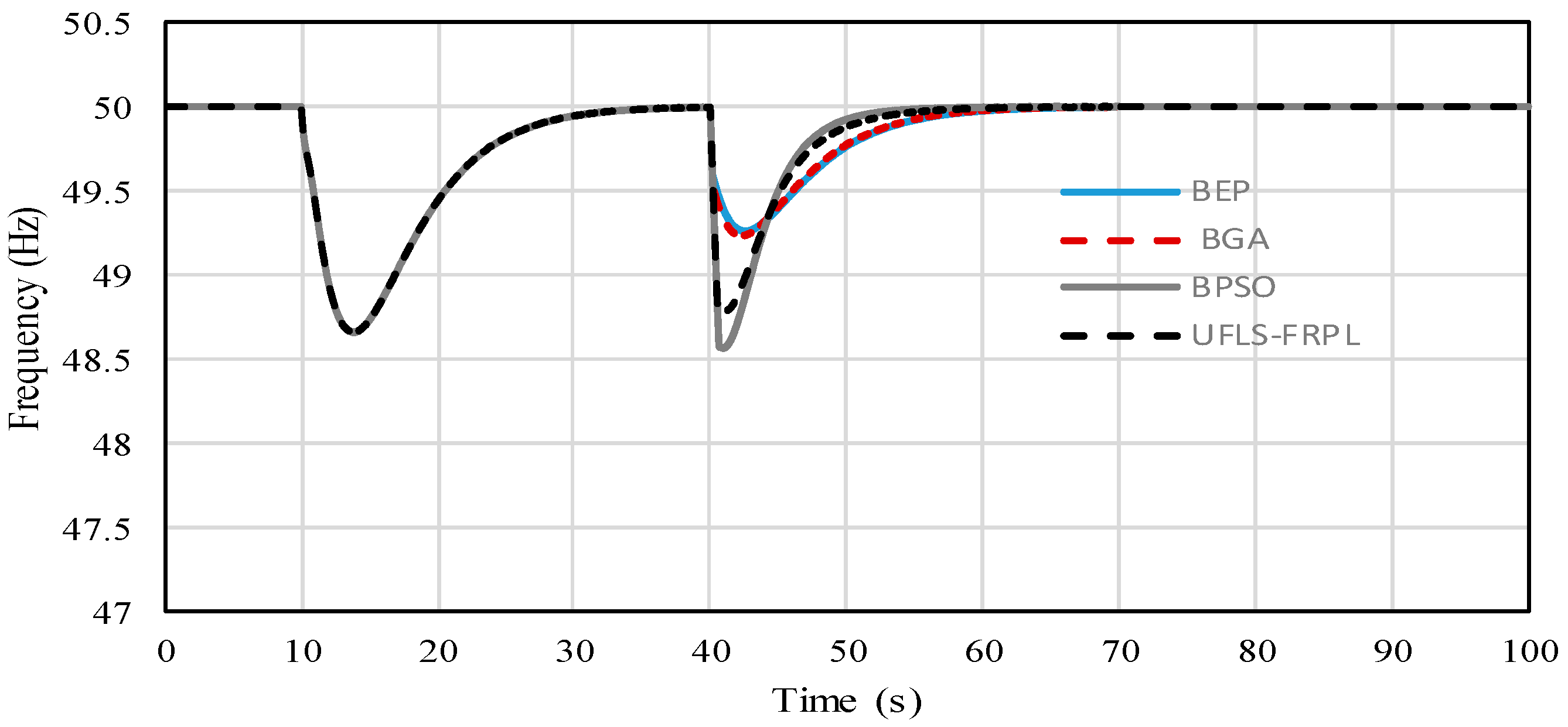
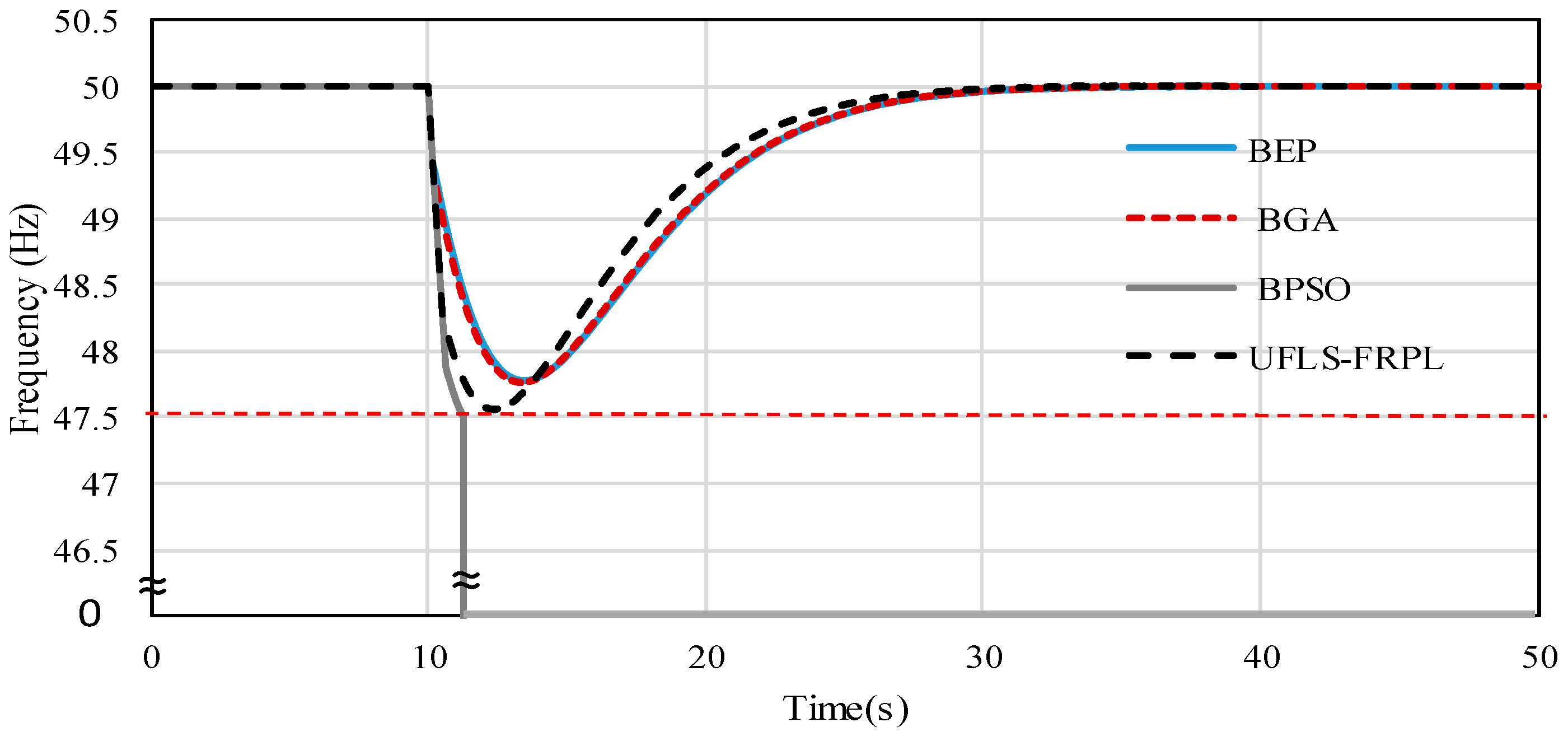
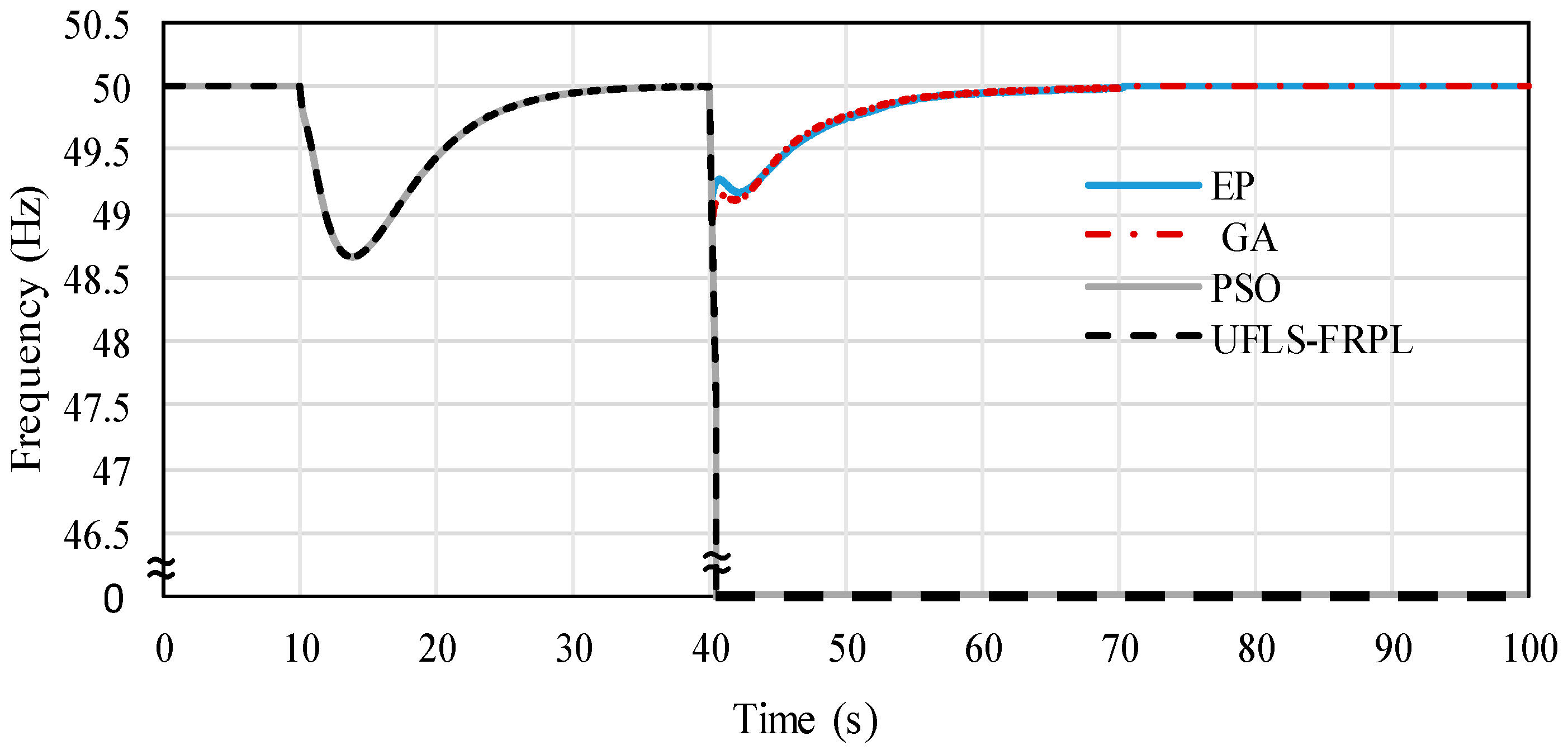
| Xi | ∑Pi-Combination (MW) | Fitness (fi) (MW) | |
|---|---|---|---|
| X1 | 1 1 0 1 0 1 0 1 0 1 | P1 + P3 + P5 + P7 + P9 + P10 = 2.091 | 1.091 |
| X2 | 0 1 0 1 0 1 0 1 1 1 | P1 + P2 + P3 + P5 + P7 + P9 = 2.041 | 1.041 |
| X3 | 0 0 0 0 1 0 0 1 1 1 | P1 + P2 + P3 + P6 = 0.783 | 0.217 |
| . | . | . | . |
| . | . | . | . |
| X20 | 0 0 0 0 0 1 1 1 1 1 | P1 + P2 + P3 + P4 + P5 = 1.012 | 0.012 |
| No. | Load Combinations | ∑Pi-Combination (MW) | Fitness fi |
|---|---|---|---|
| 1 | 0000000001 | P1 = 0.044 | 0.106 |
| 2 | 0000000010 | P2 = 0.069 | 0.081 |
| 3 | 0000000100 | P3 = 0.15 | 0 |
| 4 | 0000001000 | P4 = 0.314 | 0.164 |
| 5 | 0000010000 | P5 = 0.435 | 0.285 |
| . | . | . | . |
| . | . | . | . |
| 1023 | 1111111111 | P1 + P2 + P3 + P4 + P5 + P6 + P7 + P8 + P9 + P10 = 3.639 | 3.489 |
| Load Ranked | Bus No. | P (MW) | Proposed Priority |
|---|---|---|---|
| Load 1 | 1050 | 0.044 | Random |
| Load 2 | 1013 | 0.069 | Random |
| Load 3 | 1047, 1026 | 0.15 | Random |
| Load 4 | 1012 | 0.314 | Random |
| Load 5 | 1151 | 0.5 | Random |
| Load 6 | 1029 | 0.55 | Random |
| Load 7 | 1010, 1039 | 0.583 | Random |
| Load 8 | 1075 | 0.645 | Random |
| Load 9 | 1018, 1019, 1020, 1046 | 0.76 | Random |
| Load 10 | 1144 | 0.119 | Random |
| Load 11 | 1044 | 0.42 | Fixed |
| Load 12 | 1056 | 0.223 | Fixed |
| Parameter | Symbol | Value |
|---|---|---|
| Peak power | Pmax | 380 W |
| Open circuit voltage | Voc | 59.75 V |
| Short circuit current | Isc | 8.56 A |
| Max. power voltage | Vm | 47.9 V |
| Max. power current | Im | 7.93 A |
| Number of module connected in series | NS | 17 |
| Number of module connected in parallel | NP | 82 |
| Parameter Symbol Target | Parameter Symbol | Parameter Value |
|---|---|---|
| Input Voltage | VIN | 830 V |
| Output Voltage | VOUT | 700 V |
| Switching Frequency | fSW | 1 KHz |
| Inductor Current Ripple Ratio | LIR | 0.3 |
| Capacitor Voltage Ripple Ratio | CVR | 0.04 |
| Maximum Output Current | IOUT, MAX | 700 A |
| The Minimum Inductance Value | Lmin | 500 µH |
| The Minimum Capacitance Value | Cmin | 1000 µF |
| Parameter | Without PV Generation | With 35% PV Penetration |
|---|---|---|
| Imbalance power (MW) | 0.45 | 0.45 |
| Δf/Δt (Hz/s) | 0.6 | 0.86 |
| Nadir Frequency (Hz) | 48.5 | 48 |
| Parameter | UFLS Based BEP | Adaptive UFLS Technique |
|---|---|---|
| ΔP (MW) | 1.0 | 1.0 |
| Reserve (MW) | 0.16 | 0.16 |
| Total Load Shed Power (MW) | 0.84 | 1.07 |
| Shedding Loads | Loads 2, 3, 8 | Loads 1–5 |
| Nadir Frequency (Hz) | 49.3 | 49.5 |
| Frequency Overshoot (Hz) | - | 50.25 |
| Trial Number | Execution Time (s) | |||
|---|---|---|---|---|
| PSO | GA | BEP | UFLS-FRPL | |
| 1 | 0.646 | 0.196 | 0.162 | 0.5 |
| 2 | 0.609 | 0.179 | 0.152 | 0.5 |
| 3 | 0.626 | 0.172 | 0.155 | 0.5 |
| 4 | 0.657 | 0.178 | 0.150 | 0.5 |
| 5 | 0.605 | 0.176 | 0.153 | 0.5 |
| 6 | 0.607 | 0.189 | 0.153 | 0.5 |
| Average | 0.625 | 0.182 | 0.154 | 0.5 |
| Parameter | BEP | BGA | BPSO | UFLS-FRPL |
|---|---|---|---|---|
| ΔP (MW) | 1.0 | 1.0 | 1.0 | 1.0 |
| Reserve (MW) | 0.16 | 0.16 | 0.16 | 0.16 |
| Total Load Shed Power (MW) | 0.84 | 0.84 | 0.84 | 0.84 |
| Shedding Loads | Load 2, 3, 8 | Load 2, 3, 8 | Load 2, 3, 8 | Load 2, 3, 8 |
| Nadir Frequency (Hz) | 49.3 | 49.25 | 48.8 | 48.55 |
| Parameter | BEP | BGA | BPSO | UFLS-FRPL |
|---|---|---|---|---|
| ΔP (MW) | 1.56 | 1.56 | 1.56 | 1.56 |
| Reserve (MW) | 0.48 | 0.48 | 0.48 | 0.48 |
| Total Load Shed Power (MW) | 1.08 | 1.08 | 1.08 | 1.08 |
| Shedding Loads | Load 7, 5 | Load 7, 5 | Load 7, 5 | Load 7, 5 |
| Nadir Frequency (Hz) | 47.8 | 47.8 | 0 | 47.55 |
| Parameter | BEP | BGA | BPSO | UFLS-FRPL |
|---|---|---|---|---|
| ΔP (MW) | 1.71 | 1.71 | 1.71 | 1.71 |
| Reserve (MW) | 0.08 | 0.08 | 0.08 | 0.08 |
| Total Load Shed power (MW) | 1.63 | 1.63 | 1.63 | 1.63 |
| Shedding loads | Load 1, 4, 6, 9 | Load 1, 4, 6, 9 | Load 1, 4, 6, 9 | Load 1, 4, 6, 9 |
| Nadir Frequency (Hz) | 49.2 | 49.1 | 0 | 0 |
| Parameter | BEP | BGA | UFLS-FRPL | BPSO |
|---|---|---|---|---|
| Load priority | Fixed and random | Fixed and random | Fixed and random | Fixed and random |
| Total load shed power | Same value | Same value | Same value | Same value |
| Time execution ** | 1 | 2 | 3 | 4 |
| Frequency overshoot | Without overshoot | Without overshoot | Without overshoot | Without overshoot |
| Nadir frequency ** | 4 | 3 | 2 | 1 |
© 2017 by the authors. Licensee MDPI, Basel, Switzerland. This article is an open access article distributed under the terms and conditions of the Creative Commons Attribution (CC BY) license ( http://creativecommons.org/licenses/by/4.0/).
Share and Cite
Dreidy, M.; Mokhlis, H.; Mekhilef, S. Application of Meta-Heuristic Techniques for Optimal Load Shedding in Islanded Distribution Network with High Penetration of Solar PV Generation. Energies 2017, 10, 150. https://doi.org/10.3390/en10020150
Dreidy M, Mokhlis H, Mekhilef S. Application of Meta-Heuristic Techniques for Optimal Load Shedding in Islanded Distribution Network with High Penetration of Solar PV Generation. Energies. 2017; 10(2):150. https://doi.org/10.3390/en10020150
Chicago/Turabian StyleDreidy, Mohammad, Hazlie Mokhlis, and Saad Mekhilef. 2017. "Application of Meta-Heuristic Techniques for Optimal Load Shedding in Islanded Distribution Network with High Penetration of Solar PV Generation" Energies 10, no. 2: 150. https://doi.org/10.3390/en10020150







